Posts Tagged ‘rationing’



May 14, 1943 – The US Public Roads Administration reported that only a few states were observing the 35 mile per hour speed limit that had been imposed nationally during wartime, with vehicles traveling as fast as 45 mph in Minnesota.
Learn more about gas rationing in WWII and other changes on the Home Front.



Shoe rationing was announced to the American public on February 7, 1943. It went into effect two days later. This form (pictured below) from the Museum’s collection was designed for an individual who either had to get a replacement for recently purchased, defective shoes or “an individual who would suffer serious hardship if he were unable to obtain an extra shoe ration.” The form also ask the individual if they have a relative with an extra shoe ration and if so, why can’t they ask them for it. It was issued June 22, 1943
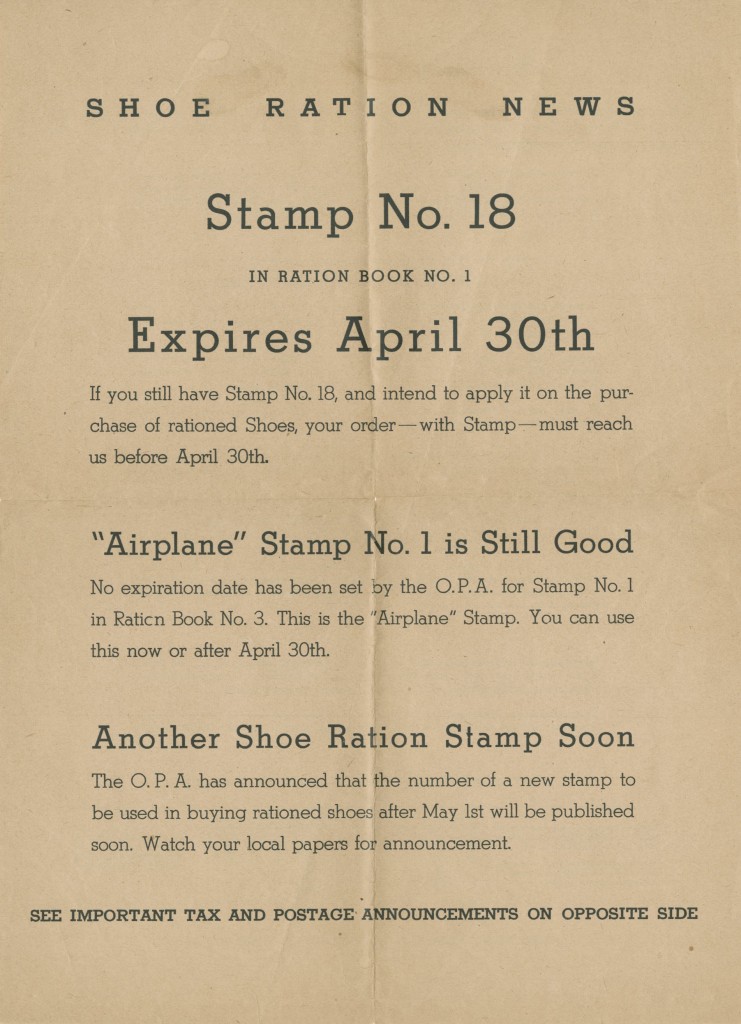
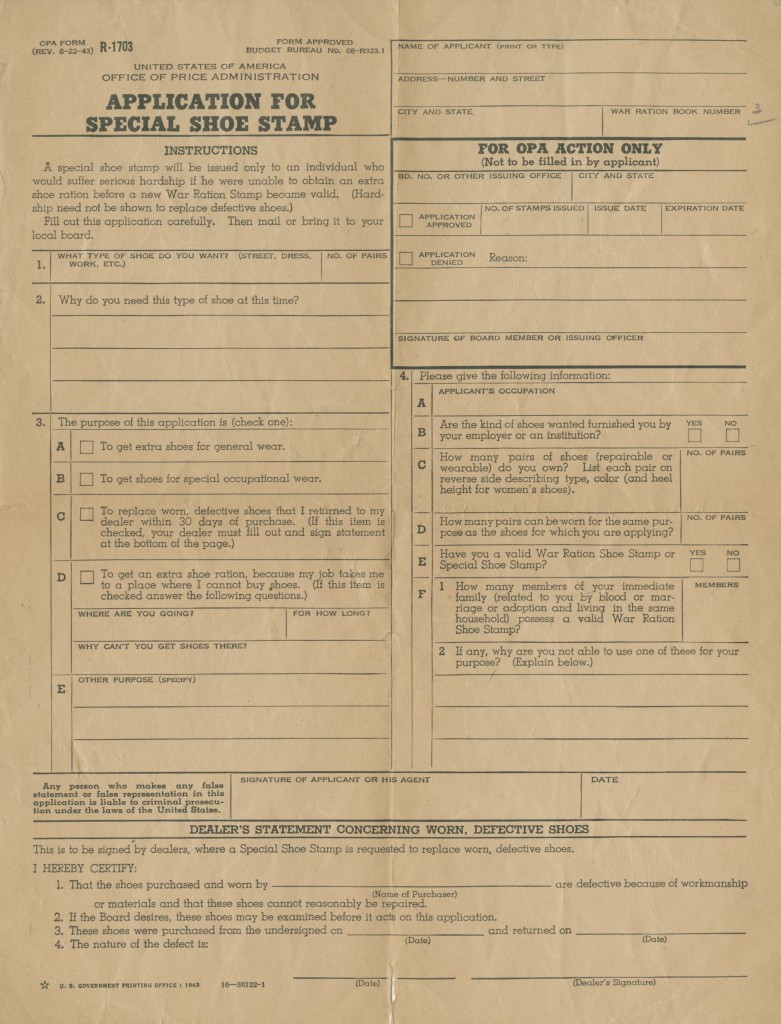
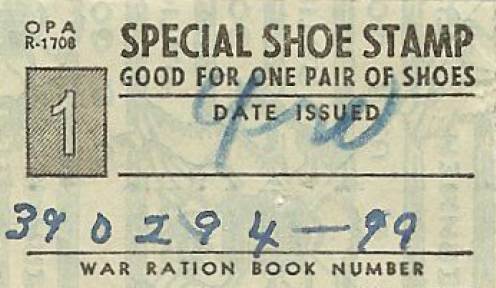
This example of a wartime shoe ration is from the Miller County Museum and Historical Society; Tuscumbia, MO.




On December 1, 1942, mandatory gas rationing went into effect.
America’s military needed millions of tires for jeeps, trucks and other vehicles. Tires required rubber. Rubber was also used to produce tanks and planes. But when Japan invaded Southeast Asia, the United States was cut off from one of its chief sources of this critical raw product.
American overcame the rubber shortage in several ways. Speed limits and gas rationing forced people to limit their driving. This reduced wear on tires. A synthetic rubber industry was created. The public also carpooled and continued rubber scrap for recycling.
All automobiles received gas ration “grade.” “A” meant nonessential. “B” indicated work use (for instance, a car used by a traveling salesman). “C” stood for essential use (for example, doctors, clergy and civil defense workers). “T” was for long-distance trucks. Most cars were graded “A,” which meant the owner received stamps for three gallons of gas per week.




Young Marines enjoy fresh coffee after successfully taking Engebi Island of Eniwetok Atoll in February 1944. Gift of Mary Noble, 2010.130.081
Beginning on 29 November 1942, coffee was rationed for citizens on the American Home Front. Doing more with less wasn’t completely new to Americans, who by this point had become accustomed to the rationing of rubber, gasoline, cheese, clothing and other goods since the beginning of that year. The consumption of milk and sugar, the butter to coffee’s bread, was also curtailed. In the wake of coffee rationing, Postum–a drink made of roasted grains meant to substitute for coffee–became exceedingly popular during the war years. Believe it or not, even acorns were used to create a java-like drink!
The rationing of coffee wasn’t due to a lack of the product–in fact it was readily available from South America–but more so due to the lack of means to ship large quantities of what was considered an unnecessary luxury in wartime, as well as the ever-present danger to US merchant ships from German U-boats. Under rationing conditions, families were allowed one pound of coffee every five weeks. However, coffee was rationed for less than a year, released from the list in July 1943.
Read all of our blog posts related to rationing.
This post by curator Meg Roussel



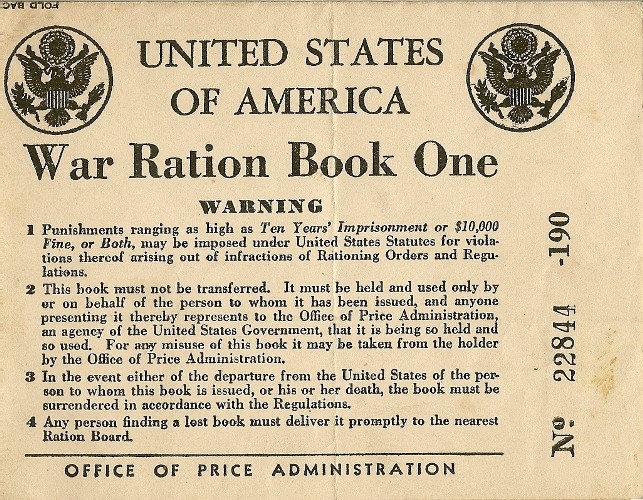
Today marks the 70th anniversary of the release of Ration Book One. Unlike today’s supermarket shelves stocked with endless product options, rationing ushered in a period of shopping wisely, monitoring spending, and limiting choices. During this time, there were shortages of many different types of goods, including refrigerators, bicycles, gasoline, stockings, and of course an array of food products.
These shortages were for a variety of reasons. Ships and trucks once used to transport foods items were now needed for soldiers and supplies at home and abroad. Sixteen million enlisted men and women along with our Allies also needed proper nourishment during wartime. These changes added up to less products on our grocery store shelves, hence the slogan and iconic poster, “Do with less so they’ll have enough!”
On May 4th 1942, the Office of Price Administration issued Ration Book One, containing stamps to purchase sugar and other later designated goods. This system ensured everybody received their “fair share” (to reference another well-known poster) and forbade the exchange or trading of stamps with any individual. Stamps had to be torn out of the book in front of the grocer, butcher, etc. to ensure that they belonged to the owner.
Yesterday, the Museum presented two webinars on the Home Front to remember this important anniversary. Students from across the country had the opportunity to experience what it was like growing up during WWII. We asked common questions of kids on the Home Front and addressed “Why can’t we buy whatever food we want at the grocery store?” Together, we shouted the answer of most busy parents, “Don’t you know there’s a war on?” and then explored the more in-depth answers. Students envisioned they were going grocery shopping during 1944, sang along to Boogie Woogie Bugle Boy, and imagined their grandparents or great-grandparents doing the jitterbug as teens and young adults.
We had over 150 sites from 34 states and over 1500 students tuning in to the webinar sessions. Fun was had by all as we were listening to “Accentuate the Positive,” watching a Looney Tunes clip about scrapping, and checking on the progress of the Museum’s Victory Garden. One school in New Jersey invited local veterans to participate along with them. Another teacher exclaimed her students were “fascinated by it! They were so interested and want more!” Some students were even inspired to start a Victory Garden and make their own ration books.
Want to learn more about rationing? Check out the Take a Closer Look gallery to examine not only ration book one, but all rationed books issued by the OPA. Explore different propaganda posters showing how our “Food is Fighting.” Take these lessons with you by printing out our latest bookmark to commemorate this milestone.
Posted by Chrissy Gregg, Virtual Classroom Coordinator at The National WWII Museum.



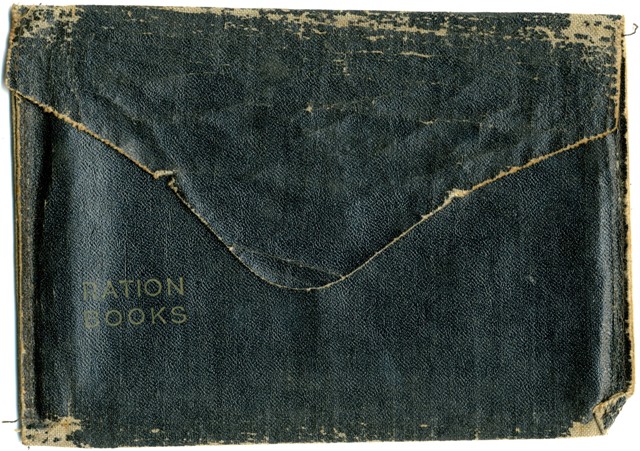
Ration books were very valuable and had to be presented to the grocery clerk. Holders like these would help protect the book and its stamps. Gift in Memory of Charles Warren and Norma T. Davis, 2011.389
On this day in 1942, the Office of Price Administration began to enforce food rationing. World War II was a total war, meaning that the entire country had to mobilize to stop the Axis threat. An American military that numbered only 630,000 in 1939 had to fill its ranks quickly. This meant that production of weapons, uniforms, and food had to increase to equip, train, and feed the growing military. As soldiers arrived overseas, they were dependent upon shipments from back home to keep them supplied. In order for the soldiers to remain well supplied, those on the home front had to conserve what they could.
Food was in short supply for a variety of reasons: much of the processed and canned foods was reserved for shipping overseas to our military and our Allies; transportation of fresh foods was limited due to gasoline and tire rationing and the priority of transporting soldiers and war supplies instead of food; imported foods, like coffee and sugar, was limited due to restrictions on importing.

The first of the ration books issued, from the Museum’s Education Collection
Notably, fresh fruit and vegetables were not initially rationed, and in fact, one of the key goals of rationing was to get Americans to cook more with fresh produce while using canned goods for those overseas. Many Americans began planting Victory Gardens, growing their own fruits and vegetables out of both necessity and patriotism. Canning at home was greatly encouraged because it would not count towards ration points.

Because of these shortages, the U.S. government’s Office of Price Administration established a system of rationing that would more fairly distribute foods that were in short supply. Every American was issued a series of ration books during the war. The ration books contained removable stamps good for certain rationed items, like sugar, meat, cooking oil, and canned goods. A person could not buy a rationed item without also giving the grocer the right ration stamp. Once a person’s ration stamps were used up for a month, she couldn’t buy any more of that type of food. This meant planning meals carefully, being creative with menus, and not wasting food. More than 8,000 ration boards across the country administered the program.
View images, secondary sources and more with this Research Starter from our National History Day program.
Check out the Museum’s onsite Victory Garden and related programming and lesson plans.
Want your students to experience artifacts like these in person? Request to borrow an artifact trunk from Operation Footlocker!
Read all of our blog posts related to rationing.
Posted by Gemma Birnbaum, Digital Education Coordinator at The National WWII Museum.



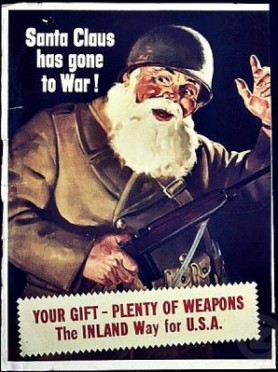
Curious about how World War II impacted the celebration of Christmas on the Home Front? So were we! In honor of tomorrow’s holiday, we’ve put together a list of fun yule-tide facts.
- Fewer men at home resulted in fewer men available to dress up and play Santa Claus. Women served as substitute Santas at Saks Fifth Avenue in New York City and at other department stores throughout the United States.
- During World War II Christmas trees were in short supply because of a lack of manpower (to cut the trees down) and a shortage of railroad space to ship the trees to market. Americans rushed to buy American-made Visca artificial trees.
- Travel during the holidays was limited for most families due to the rationing of tires and gasoline. Americans saved up their food ration stamps to provide extra food for a fine holiday meal.
View all these fun facts at Christmas at a Glance and download a printable fact sheet
Posted by Gemma Birnbaum, Digital Education Coordinator at The National WWII Museum.




On November 23, 1945, the wartime rationing of most foods ended. Ask anyone who remembers life on the Home Front during WWII about their strongest memories and chances are they will tell you about rationing. In addition to shortages of rubber, metal, clothing, and other materials, there were shortages of various types of food that effected just about everyone on a daily basis.
Food was in short supply for a variety of reasons: much of the processed and canned foods was reserved for shipping overseas to our military and our Allies; transportation of fresh foods was limited due to gasoline and tire rationing and the priority of transporting soldiers and war supplies instead of food; imported foods, like coffee and sugar, was limited due to restrictions on importing.
Holidays like Thanksgiving were quite different during wartime on the Home Front. Many families missed parents and siblings who were overseas fighting. Items like your Thanksgiving turkey would be nearly impossible to find. Even a tradition as simple as a football game was suspended; the Detroit Lions, who have hosted an annual Thanksgiving game since 1934, put this tradition on hold between 1939-1944.
This Thanksgiving, when you think about what you are thankful for, consider the soldiers and families that have sacrificed and continue to sacrifice for the war effort. How do you think they celebrated, given the challenges they faced?
Learn more about Rationing in our Take a Closer Look Gallery
Teachers, download primary sources to teach about Rationing in WWII!
Read all of our blog posts related to rationing.
Posted by Gemma Birnbaum, Digital Education Coordinator at The National WWII Museum.



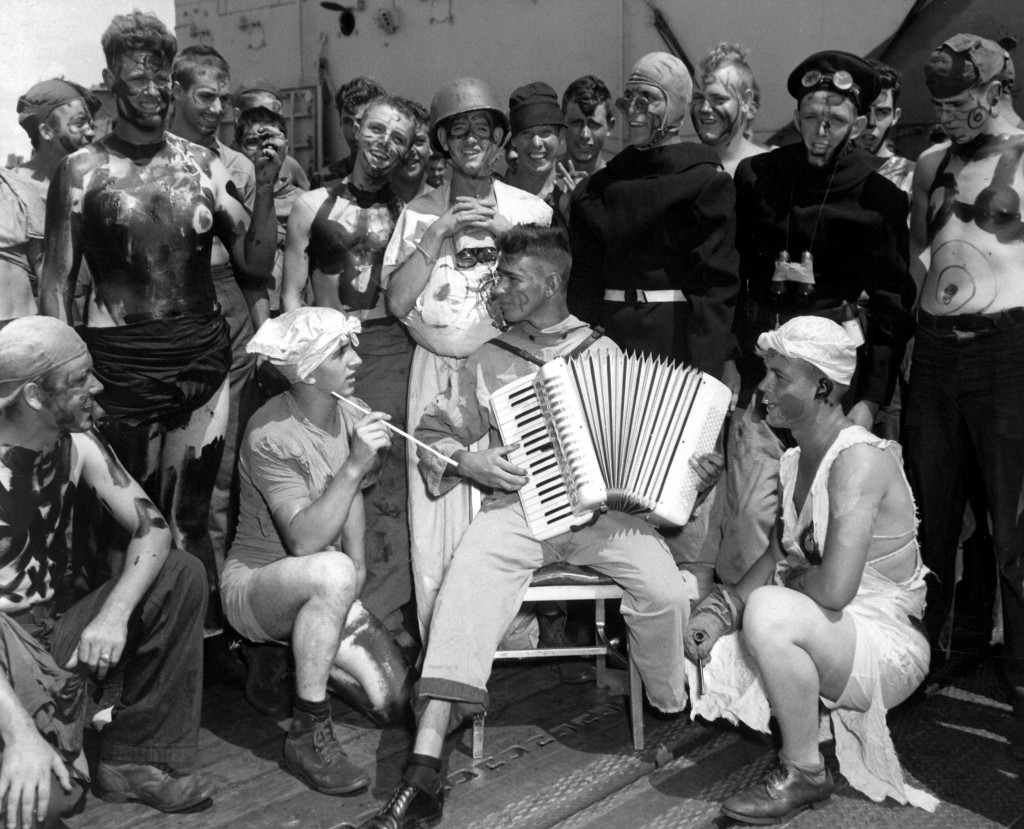
The USS Enterprise crosses the line, 1943. Courtesy of the National Archives.
Though Halloween as we know it wasn’t the norm in the 1940s, due in some part to sugar rationing, the US Navy and one of its many quirky traditions serves nicely as a Halloween tie-in. Crossing-the-Line ceremonies involved elaborate costuming and references to age-old legends and characters like the eerie Davy Jones & regal Queen Amphitrite.
The celebration of “crossing the line” was for servicemen’s first time sailing over the Equator, Prime Meridian, or International Date Line. Although not always practiced in wartime, the ceremony served as both a bonding experience and morale booster, even if in reality the organized hazing often resulted in men having to spend time in the sick bay. The event almost always included the same sets of characters and rituals. All activities were reigned over by King Neptune and his Queen Amphitrite, who were aided by Davy Jones and his band of pirates all of whom served as the “court.” The court was made up of Shellbacks, or those men who had already crossed the line and been initiated.
(more…)




The National WWII Museum is excited to announce that we will be building a victory garden onsite at the Museum on September 23rd and 24th. Leading up to the garden build we will be providing you with stories and recipes from the victory gardens of the war years.
UPDATE: The National WWII Museum Victory Garden is now open and thriving.
One big wartime message in the 1940s was the importance of stretching your dollar – and your food. That’s a big reason why people planted victory gardens in the first place; if people could grow their own veggies, more could be sent to troops overseas. Victory gardens provided almost 40 percent of vegetables grown in the U.S. during the war! Combine that with rationing, and people were conscious of using every bit of food they bought or grew and not letting any go to waste. Of course, this led to some odd combinations, like cream cheese and carrot sandwiches and baked beans in applesauce. But in the spirit of ingenuity – especially in the difficult economic times we’re living in – we’ve featured some creative recipes for stretching your leftovers into some fun appetizers! All of these recipes were found in The Wartime Cook Book, published in 1942.
(more…)

















